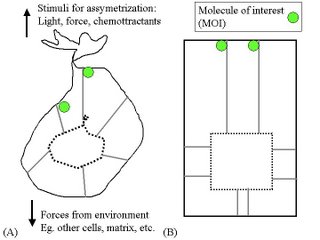
Self-organization as a principle in generating patterns in living systems in increasingly being put forth as a general mechanism. Take for instance the following line:
A living cell is not an aggregate of molecules but an organized pattern, structured in space and in time [1]
The same author in the review [1] goes on to say that he would like to address:
conceptual issues in the genesis of spatial architecture, including how molecules find their proper location in cell space, the origins of supramolecular order, the role of the genes, cell morphology, the continuity of cells, and the inheritance of order.
dna -> rna ->proteins
as contrasted with the principles of "self-organization". That we see phenotypic effects of knoking out a gene is beyond doubt. But that we cannot explain the formation of polarized cells based on the genetic information. Or even that of the "interactome" is also becoming apparent. So what are these "principles". Are the general principles from physics already sufficient to account for these effects? How can such principles be at once adaptive and produce the same patterns?
I am still thinking of more questions and would happily post more if anybody chances upon this.
References
[1] Harold F.M. (2005) Molecules into Cells: Specifying Spatial Architecture.Microbiology and Molecular Biology Reviews, Vol. 69 (4), pp 544-564.
1 comment:
Post more questions as I have chanced upon this :)
I study self organization for a living. Everyday I look at self-organization and think how did it come about. My PhD thesis is fortunately and at the same time quite unfortunately essentially on the rules of a classically self organizing system; fortunate because its such a problem it makes me work in the face of all obstacles, being such a formidable, and romantic a problem and unfortunate because having worked on it especially in relevance to biological paradigms, I know its solution lies during the lifetime of probably my grandchild, if not further away.
But we can talk more meat later. This was just a substitution for the words, "Hello mate!"
Post a Comment